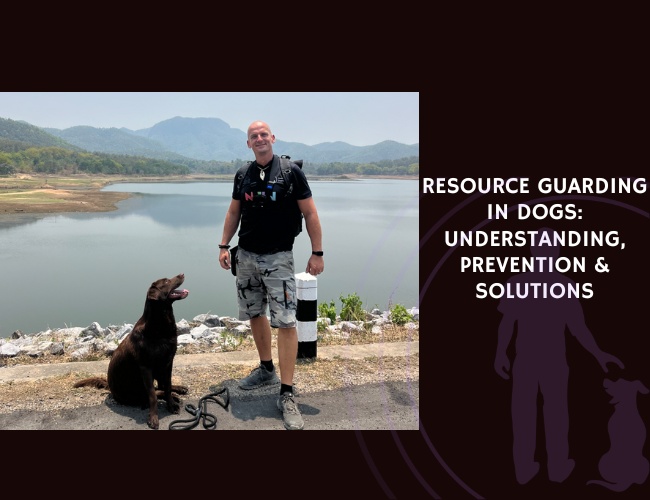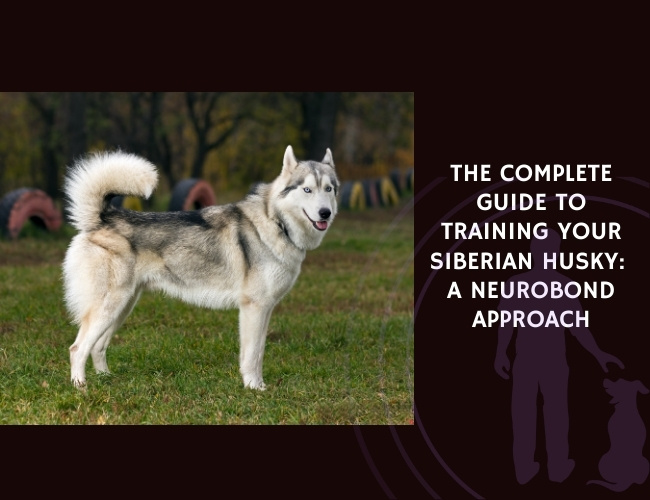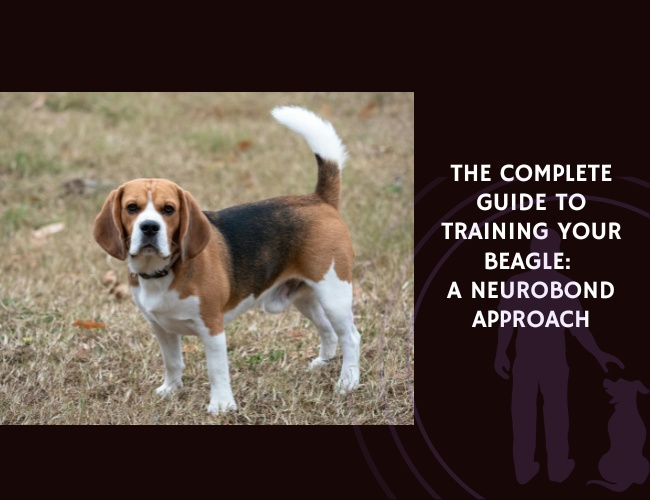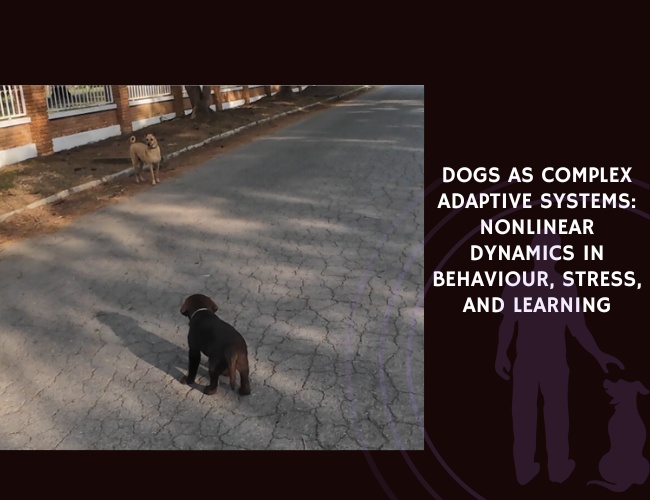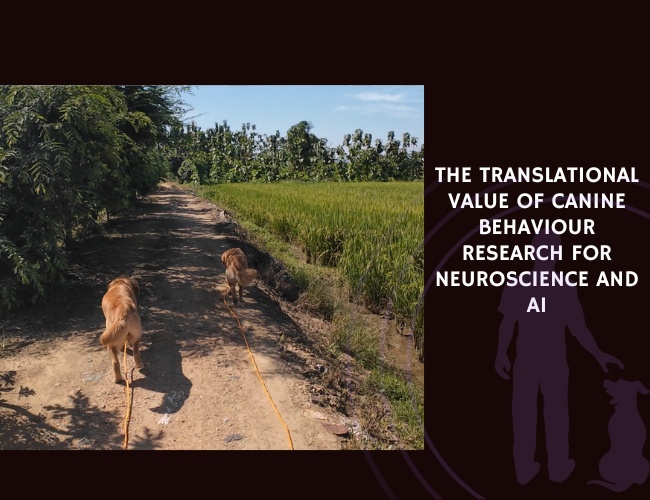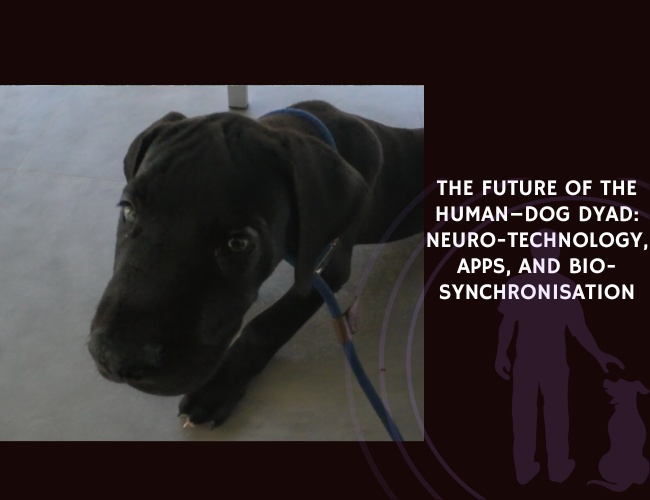Introduction: When Your Furry Friend Says “Mine!”
Have you ever noticed your gentle companion suddenly transform when approached during mealtime? That stiffening body, the low growl, or the way they position themselves between you and their favorite toy? You’re witnessing resource guarding—a behavior as natural to dogs as wagging their tails, yet one that can challenge even the most loving human-canine relationships.
Resource guarding touches nearly every dog owner’s life at some point, whether it’s a puppy protecting their first bone or a rescue dog carrying invisible scars from past scarcity. Let us guide you through understanding this complex behavior, not as a character flaw in your beloved pet, but as an evolutionarily adaptive response that, with patience and knowledge, can be successfully managed and often prevented entirely.
Understanding Resource Guarding: More Than Just “Being Possessive”
What Resource Guarding Really Means
The majority of canine behavior experts today prefer the term “resource guarding” over the outdated “possessive aggression,” and for good reason. Resource guarding encompasses the use of avoidance, threatening, or aggressive behaviors by a dog to retain control of items they value—in the presence of a person or another animal. It’s not about dominance or spite; it’s about survival instincts meeting modern living situations.
You might notice resource guarding manifesting in three distinct patterns. Rapid ingestion occurs when your dog practically inhales their food the moment someone approaches. Avoidance behaviors involve your dog positioning their head or body to block access to the item, or even picking it up and moving to another location. The third pattern, aggression, ranges from subtle warnings like freezing and hard stares to more obvious displays like growling, snapping, or biting.
What makes this behavior particularly challenging is its variability. Your normally social butterfly of a dog might guard only their evening meal, while another might protect everything from tissues to their favorite human. Understanding these nuances helps us approach each dog as an individual, not just a collection of breed characteristics.
The Evolutionary Logic Behind the Behavior
Resource guarding isn’t a flaw—it’s an evolutionary masterpiece. In wolves and wild canids, protecting valuable resources meant survival. Those who successfully defended their food lived to pass on their genes. Our domestic dogs carry this ancient wisdom in their DNA, even though their food bowls are reliably refilled twice daily.
Interestingly, research comparing wolves and dogs reveals fascinating insights. In group settings, wolves actually show more cooperative feeding behaviors than domestic dogs, with rank being the primary determining factor. Dogs, however, show greater individual variation in their guarding behaviors—a testament to thousands of years of selective breeding that prioritized physical traits over behavioral consistency. This means your neighbor’s Golden Retriever and your Chihuahua might have vastly different approaches to resource protection, despite both being “dogs.”
Age-Specific Protocols: Tailoring Approaches Through Life Stages
The Adolescent Challenge: 6-18 Months
Just when you thought you’d figured out your puppy, adolescence hits like a storm. This “teenage” phase brings hormonal surges, brain reorganization, and often, the sudden emergence or intensification of resource guarding. Your previously sharing puppy might suddenly guard their food bowl with shocking intensity. This isn’t regression—it’s a developmental phase requiring adjusted strategies.
Adolescent dogs test boundaries as their confidence grows. The resource guarding that emerges during this period often reflects newfound independence rather than deep-seated anxiety. They’re asking, “Do the old rules still apply? What happens if I say no?” Your response during these months sets patterns for adulthood, making consistency crucial even when faced with frustrating “teenage rebellion.”
Training protocols need modification for adolescent attention spans and energy levels. Keep sessions shorter but more frequent—five 3-minute sessions beat one 15-minute session. Increase the value of your trades significantly; adolescent dogs need higher motivation to overcome their growing independence. Exercise before training becomes essential—a tired teenager is a more focused student.
Senior Dogs and Cognitive Changes
Senior dogs present unique resource guarding challenges, often developing the behavior for the first time in their golden years. Cognitive dysfunction syndrome (doggy dementia) can trigger guarding in previously easy-going dogs. They might forget where resources come from, leading to protective behaviors born from confusion rather than competition.
Pain-induced guarding becomes increasingly common. That sweet senior who suddenly guards their bed might have arthritis making movement painful. They’re not becoming mean; they’re protecting themselves from pain they anticipate when forced to move. Vision or hearing loss adds another layer—they can’t see or hear approach, making “surprise” interactions feel threatening.
Protocols for seniors require exceptional gentleness. Move even slower than with younger dogs. Use higher-value trades to account for potentially decreased food motivation. Consider medication evaluation for both pain and cognitive support. Create predictable routines that don’t require quick movements or decisions. Most importantly, adjust expectations—management might become more important than modification for quality of life.
Life Transitions and Resource Guarding
Major life changes can trigger resource guarding in dogs of any age. Pregnancy brings hormonal changes that might increase protective behaviors. New mothers might guard puppies, food, or nesting areas with unexpected intensity. This usually resolves post-weaning but requires careful management to prevent habit formation.
Illness and post-surgery recovery create vulnerability that triggers guarding. Your dog feels weak, perhaps painful, and instinctively protects resources they might normally share. Pain medications can help, but behavioral management remains crucial. Create safe spaces where your recovering dog won’t be disturbed. Temporarily suspend training that might cause stress, focusing instead on management and comfort.
Moving homes disrupts every resource association your dog has built. Previously reliable dogs might guard in the new environment until they map resource availability. Maintain feeding routines from your previous home. Bring familiar bowls, beds, and toys. Gradually introduce new spaces rather than allowing immediate full access. This transition period typically lasts 3-4 weeks but can extend longer for sensitive dogs.
Developmental Timing for Interventions
Each life stage has optimal intervention windows. Puppies (8-16 weeks) absorb prevention protocols like sponges—focus on positive associations and trade games. Juveniles (4-6 months) benefit from structured training as attention spans increase. Adolescents (6-18 months) need consistent boundaries despite their testing. Adults (18 months-7 years) have the maturity for complex behavior modification protocols.
Seniors (7+ years) require adapted approaches prioritizing comfort over compliance. Never assume it’s “too late” to help a senior dog, but adjust methods to honor their physical and cognitive limitations. Success might look different—a senior who learns to tolerate approach at 6 feet versus 2 feet has still made meaningful progress.
The Science Behind the Behavior: Neurological and Emotional Foundations
The Brain’s Security System
When your dog guards resources, their brain orchestrates a complex neurobiological response. The hypothalamic-pituitary-adrenal (HPA) axis—think of it as your dog’s internal stress management system—plays a crucial role. Under stress, this system triggers cortisol production, preparing the body for action. Dogs with resource guarding issues often show HPA axis dysregulation, meaning their stress response system is essentially stuck in overdrive.
Serotonin, that feel-good neurotransmitter we hear so much about in human mental health, plays an equally important role in our canine companions. Research consistently links serotonin deficiency to increased aggression and resource guarding behaviors. It’s like trying to stay calm and rational when you’re running on empty—everything feels more threatening, more urgent, more worth protecting.
Emotional Drivers: Fear, Impulsivity, and Loss
Behind every growl over a food bowl lies an emotional story. Dogs with higher levels of impulsivity are significantly more likely to display all three patterns of resource guarding—rapid ingestion, avoidance, and aggression. Imagine feeling like every meal might be your last, every toy might disappear forever. That urgency, that inability to pause and think “there’s plenty more where that came from,” drives impulsive guarding behaviors.
Fear adds another layer to this emotional complexity. Fearful dogs are particularly prone to aggressive resource guarding, creating a vicious cycle where the fear of losing resources leads to behaviors that often result in exactly what they feared—humans taking things away. Understanding these emotional underpinnings transforms how we approach treatment, shifting from punishment-based “dominance” tactics to compassion-based interventions that address the root causes.
Risk Factors and Development: Why Some Dogs Guard More Than Others
Genetic and Breed Influences
While modern research reveals that breed explains only a small portion of behavioral variation between individual dogs, certain genetic tendencies do exist. Mixed breeds, interestingly, show higher rates of resource guarding aggression compared to purebreds—possibly due to more diverse genetic influences or different early life experiences. Neutered males also demonstrate increased guarding behaviors, though the exact mechanisms remain unclear.
What’s crucial to understand is that breed should never be your sole predictor of guarding behavior. That “typically friendly” Labrador might guard intensely, while that “naturally protective” German Shepherd might happily share everything. Individual personality, shaped by genetics, early experiences, and ongoing environment, matters far more than breed stereotypes.
Early Life Experiences That Shape Guarding
The critical period between 2 and 7 weeks of age functions like a behavioral programming window. During this time, puppies learn fundamental lessons about resources, sharing, and security. Puppies from large litters who had to compete for limited nursing spots often develop stronger guarding tendencies. Those hand-raised without littermates might miss crucial lessons about give-and-take.
Resource scarcity during development—whether real or perceived—leaves lasting impacts. A puppy who experienced irregular feeding, had to compete with many siblings, or came from a hoarding situation might carry those survival strategies into their new, resource-abundant home. These aren’t character flaws; they’re adaptations to past circumstances that no longer apply.
Owner Actions That Inadvertently Increase Guarding
Sometimes, our well-intentioned actions backfire spectacularly. Research shows that removing a dog’s food dish during mealtime—often done to “show who’s boss”—actually increases the likelihood of more severe resource guarding behaviors. Think about it from your dog’s perspective: every meal becomes a test, a potential loss, a reason to guard more intensely next time.
Similarly, punishment-based training methods consistently worsen resource guarding. When we punish a dog for growling over their food, we don’t eliminate the emotional state causing the guarding—we simply teach them to skip the warning and go straight to biting. It’s like disabling a smoke alarm because the sound annoys you; the fire hazard remains, but now you’ve lost your early warning system.

Recognition and Assessment: Reading the Signs Before They Escalate
The Complete Body Language Dictionary: From Whispers to Shouts
Most dog owners easily recognize obvious resource guarding aggression—the growl, the snap, the lifted lip. But dogs begin communicating their discomfort long before these dramatic displays. Think of resource guarding body language as a ladder, with each rung representing an escalation in communication intensity. Your dog always starts at the bottom, climbing higher only when their quieter messages go unheard.
Level 1: The Whispers (Subtle Stress Signals)
These nearly invisible signals are your dog’s polite requests for space. Lip licking when no food is present signals mild anxiety. Yawning outside of tiredness contexts communicates stress. Head turns away from you while keeping the resource in peripheral vision say, “I’d prefer you didn’t come closer.” You might notice blinking that seems excessive or deliberate, almost like your dog is trying to avoid eye contact without fully looking away.
Displacement behaviors offer another subtle clue. Your dog might suddenly scratch themselves, sniff the ground intensely, or shake off as if wet—all signs of internal conflict. They want the resource but feel stressed about potential competition. These behaviors buy them time to assess the situation while self-soothing.
Level 2: Clear Communication (Obvious Discomfort)
When whispers go unheard, dogs speak louder. The famous whale eye—showing the whites of their eyes while keeping their head still—screams discomfort. Freezing over the resource, becoming statue-still except for those watching eyes, represents heightened vigilance. Body blocking involves positioning themselves between you and the resource, using their body as a barrier.
Watch for resource hovering, where your dog crouches low over the item, perhaps with one paw placed possessively on top. Speed eating accelerates dramatically—your leisurely diner transforms into a competitive eater. The hard stare fixes on approaching threats with laser focus, often accompanied by visible muscle tension through the shoulders and back.
Level 3: Serious Warnings (Pre-Bite Signals)
These signals precede bites by seconds or less. Growling starts low and rumbly, increasing in intensity if approach continues. Lip lifting reveals teeth—first just the front canines, then progressively more if warnings continue being ignored. Snarling combines the growl with a fully wrinkled muzzle, maximum teeth display, and often raised hackles along the spine.
Air snapping—biting the air near the threat—is your dog’s final warning shot. They’re demonstrating capability and intent without making contact. Lunging while still restrained by the resource (not fully committing to attack) shows a dog pushed nearly to their limit. These aren’t bad dogs; they’re dogs whose every previous attempt at communication has failed.
Breed-Specific Variations in Expression
Different breeds express guarding through their unique anatomical and behavioral tendencies. Brachycephalic breeds (Bulldogs, Pugs, Boston Terriers) may show less obvious facial expressions due to their shortened muzzles. Watch instead for body stiffening, shoulder rolling forward, and that characteristic broad-based stance. Their growls might sound more like snorts, but take them equally seriously.
Herding breeds often show “eye”—that intense, fixed stare they’d use on sheep—before escalating to other warnings. They might circle resources or use body pressure to move you away. Nordic breeds tend toward quieter warnings, perhaps just a hard stare and rigid body, before escalating quickly. Sight hounds might show more obvious body curving around resources, using their flexible spines to create protective C-shapes.
Terriers often display quick escalation with less warning—their bred-for tenacity means they might skip subtle signals. Guardian breeds might show more spatial guarding, creating larger buffer zones around resources. Remember, these are tendencies, not rules—individual personality always matters more than breed.
Recovery Signals: Your Dog Is Calming Down
Recognizing when your dog is de-escalating helps you gauge intervention success. Soft eyes return first—that hard, fixed stare melts into normal, relaxed eye contact. Play bows or play sneezes indicate emotional shift toward positive states. Shake offs (like they’re wet) help reset their emotional state—it’s like their system rebooting.
Yawning and stretching (the relaxed kind, not stress yawning) shows decreasing tension. Soft tail wags at medium height indicate improving mood. Re-engagement behaviors like bringing you toys, seeking pets, or performing trained behaviors voluntarily show your dog has moved past the guarding episode. Normal eating speed returns, replacing that frantic gobbling. These recovery signals tell you when it’s safe to gradually resume normal interaction.
Professional Assessment Tools
Veterinary behaviorists and certified trainers use standardized tools like the C-BARQ (Canine Behavioral Assessment & Research Questionnaire) to evaluate resource guarding objectively. This validated tool, containing behavioral evaluations for over 50,000 dogs across 300+ breeds, helps identify patterns you might miss in daily life.
Professional assessment goes beyond just identifying the behavior—it maps the triggers, intensity, and recovery patterns. How long does your dog stay tense after a guarding incident? What specific contexts trigger the behavior? These details shape effective treatment plans tailored to your individual dog’s needs.
Prevention Strategies: Building Security from Puppyhood
The Golden Window: 3-14 Weeks
If you’re raising a puppy, you hold the keys to prevention during those crucial early weeks. The extended sensitive period from 3 to 14 weeks offers unparalleled opportunities to shape your puppy’s relationship with resources. This isn’t about taking things away to “show dominance”—it’s about creating positive associations with human approach and involvement.
Hand-feeding builds trust foundations. Start by feeding some meals directly from your hand, making yourself the source of good things rather than the threat to them. Gradually progress to dropping special treats into their bowl while they eat, teaching them that human approach means “bonus,” not “loss.”
The “trade game” becomes your prevention superpower. From the earliest days, teach your puppy that giving up one resource leads to getting something even better. Start with low-value items—that boring rope toy—and trade for high-value treats. Your puppy learns a crucial life lesson: cooperation with humans leads to better outcomes than guarding.
Creating Abundance Mindset
Dogs who believe resources are abundant rarely guard intensely. Creating this abundance mindset doesn’t mean unlimited food (we don’t want obesity!), but rather predictable, reliable access to needs being met. Regular meal times, consistent treat opportunities, and multiple toys available reduce the perceived need to protect any single resource.
In multi-dog households, separate feeding stations prevent competition that can trigger guarding. Each dog needs their own space, their own bowl, their own security. This isn’t giving in to bad behavior—it’s preventing the stress that creates bad behavior. Management is prevention, and prevention is always easier than cure.
Socialization Beyond the Dog Park
True socialization for resource guarding prevention goes beyond meeting other dogs and people. It involves systematic, positive exposure to various handling scenarios. Gently touch your puppy while they eat (then add something delicious to their bowl). Practice examining their mouth (followed by treats). Handle their toys (then give them back with a bonus).
Young puppies naturally compete with littermates for resources, so your socialization must counteract this early programming. Teach them that sharing spaces, allowing approach, and even giving up resources leads to positive outcomes. This requires consistency, patience, and hundreds of positive repetitions during those crucial early months.
Protective. Instinctive. Manageable.
Guarding is survival. What looks like possessiveness is an ancient instinct to secure resources, from food to toys. Dogs aren’t acting out of spite, but from deeply wired behaviors shaped by evolutionary necessity.
Signals reveal intent. Rapid eating, blocking access, or growling all stem from the same drive to protect. These varied patterns remind us that resource guarding is not uniform, but unique to each dog’s triggers and thresholds.
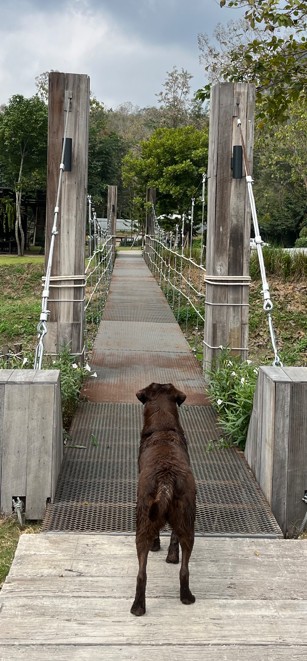
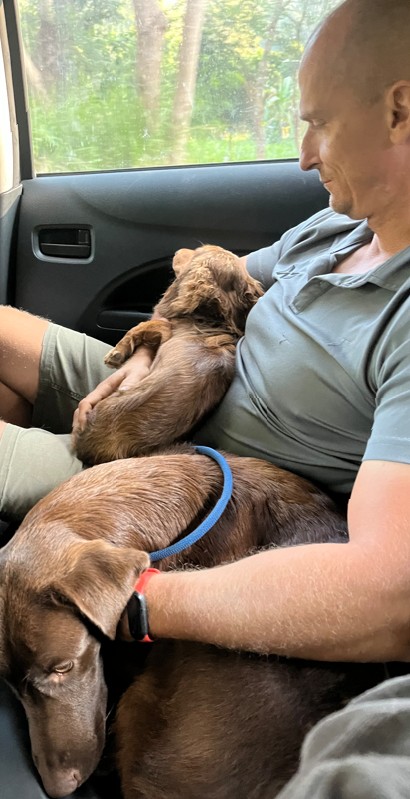
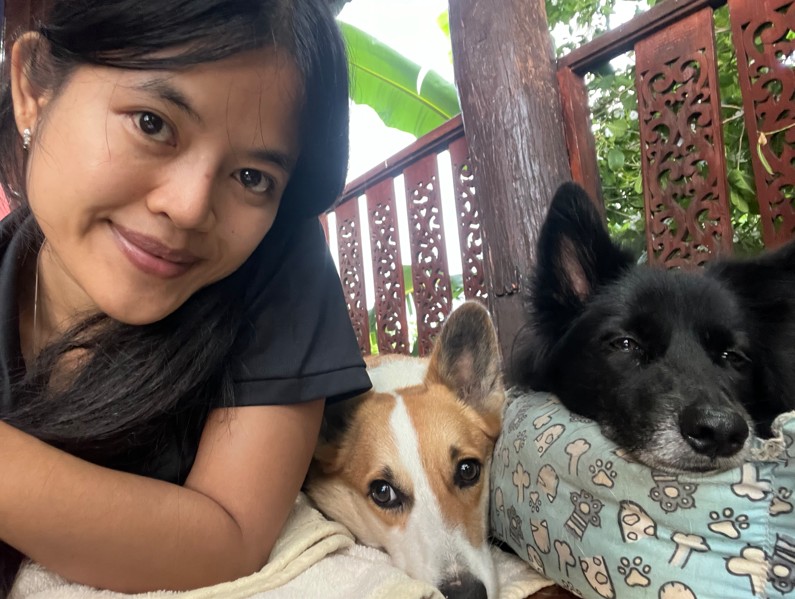
Prevention builds trust. By approaching meals and valued items with calm consistency and positive associations, we teach dogs that sharing isn’t threatening. With patience, guarding transforms into confidence and cooperation.
Detailed Training Protocols: Your Step-by-Step Roadmap
Week-by-Week Training Calendar: The First Month
Week 1: Foundation Building (Assessment and Trust)
Days 1-3: Observation Phase
- Document all resources your dog guards (food, toys, locations, people)
- Note trigger distances—how close can you get before seeing stress signals?
- Record intensity levels using the body language ladder
- Identify your dog’s highest-value trades (cheese? Chicken? Liver treats?)
- No training yet—just gather data
Days 4-7: Introduction to Positive Associations
- Stand at your dog’s comfort distance (where they notice but don’t react)
- Toss high-value treats toward them, then walk away
- Repeat 5-10 times per meal
- Success looks like: tail wagging or happy body language when you approach at distance
- If you see stress signals, you’re too close—increase distance tomorrow
Week 2: Building the Trade Game
Days 8-10: Low-Value Item Trades
- Start with boring items (old rope toy, empty Kong)
- Say “trade,” show the amazing treat, wait for drop
- Give treat, then return the item plus bonus treat
- Practice 10 trades daily with different low-value items
- Success: voluntary dropping within 3 seconds
Days 11-14: Systematic Desensitization Begins
- Approach food bowl at comfort distance while dog eats
- Toss high-value treat into bowl
- Retreat immediately
- Decrease distance by 6 inches if no stress signals for 3 consecutive meals
- Record exact distances—use tape on floor if needed
- Success: decreased distance by at least 18 inches from starting point
Week 3: Increasing Complexity
Days 15-17: Duration and Proximity Work
- Stand at week 2’s final distance for increasing durations
- Start: 1 second, build to 10 seconds by day 17
- Continue treat tosses but vary timing
- Add gentle talking while standing there
- Success: relaxed body language for 10-second duration
Days 18-21: Medium-Value Trades
- Progress to medium-value items (favorite regular toys, dental chews)
- Trade protocol remains the same but expect slower drops
- Increase treat value if needed
- Practice “drop it” cue from 3 feet away
- Success: 80% success rate on first cue
Week 4: Real-World Application
Days 22-24: Movement Patterns
- Walk past food bowl in normal manner (not sneaking)
- Toss treat as you pass
- Practice different approach angles
- Add normal household activities nearby
- Success: dog continues eating relaxed as you pass
Days 25-28: Proofing and Generalization
- Practice in different rooms
- Different family members participate (one at a time)
- Vary times of day
- Add mild distractions
- Success: consistent relaxed response across contexts
Exact Distances, Durations, and Repetitions
Distance Progressions:
- Start: Dog’s trigger distance (typically 6-10 feet)
- Week 1: Maintain starting distance
- Week 2: Decrease by 6 inches every 2 successful days
- Week 3: Decrease by 3 inches daily if successful
- Week 4: Work at 2-3 feet, normal household distances
Duration Building:
- Week 1: Brief 1-second presence
- Week 2: Build to 3 seconds
- Week 3: Build to 10 seconds
- Week 4: Variable durations up to 30 seconds
Repetition Guidelines:
- Formal training: 3-5 sessions daily, 5-10 repetitions each
- Informal practice: Every natural opportunity
- Trade games: Minimum 10 daily
- Never exceed 15 minutes per session
- Stop on success, not failure
Troubleshooting Common Training Mistakes
Mistake 1: Moving Too Fast Signs: Increased guarding, regression to earlier warnings, avoidance of training Solution: Return to last successful distance/stage for 3 days before progressing Prevention: Use “2 days successful = 1 step forward” rule
Mistake 2: Inconsistent Rewards Signs: Slow response to cues, decreased enthusiasm, selective compliance Solution: Audit your treats—are they truly high-value? Use variety Prevention: Keep training treats special—never use them outside training
Mistake 3: Poisoned Cues Signs: Dog shows stress when hearing “drop it” or “trade” Solution: Change the cue word entirely, rebuild from scratch Prevention: Never use cues during negative experiences or forced takes
Mistake 4: Family Inconsistency Signs: Works for one person, not others; confused responses Solution: Family training meeting, written protocols posted in kitchen Prevention: Everyone watches initial training, takes turns under supervision
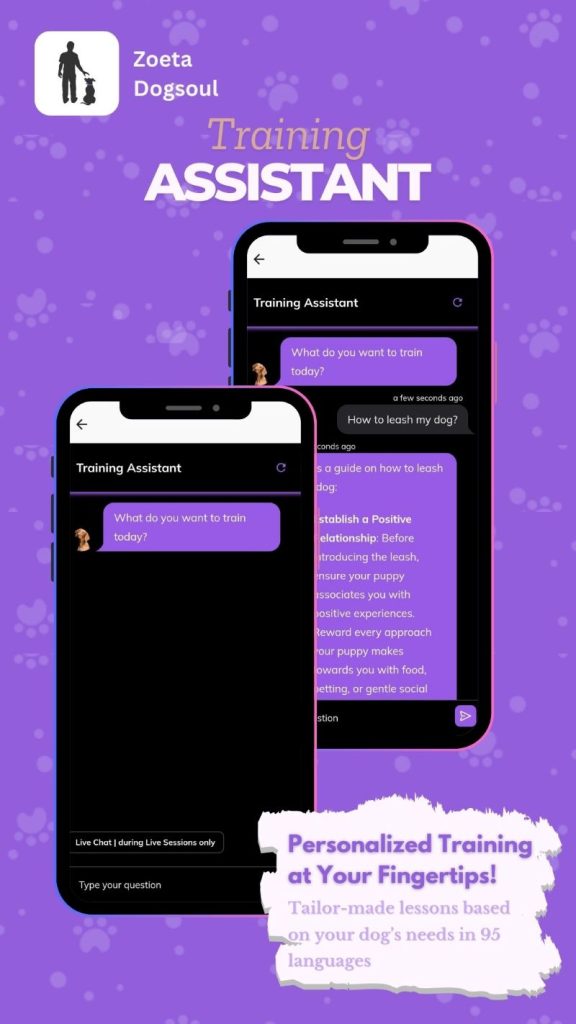
Scenario-Specific Recipe Cards
Recipe Card: Food Bowl Guarding
Ingredients: High-value treats, meal portions, 10 minutes Steps:
- Place 1/4 of meal in bowl
- Let dog begin eating
- Approach to comfort distance
- Say dog’s name happily
- Toss amazing treat into bowl
- Retreat and wait for finishing
- Repeat with next 1/4 portion
- Gradually decrease distance over 2 weeks Success Indicator: Dog looks up hopefully when you approach during meals
Recipe Card: Couch Guarding
Ingredients: Treats, alternative resting spot, patience Steps:
- Make alternative spot more appealing (better bed, heated pad)
- Reward choosing alternative spot (treats rain from sky!)
- Practice “off” with immediate “up” invitation back
- Trade couch access for tricks (sit = invitation up)
- Never physically remove—always use trades/cues Success Indicator: Dog voluntarily moves when asked, returns when invited
Recipe Card: Owner Guarding (From Other Pets/People)
Ingredients: Distance, treats, controlled setups Steps:
- Guarded person sits still
- Helper approaches to trigger distance
- Guarded person gives dog treats during approach
- Helper retreats
- Repeat, decreasing distance gradually
- Add helper tossing treats too
- Practice musical chairs—switching who’s “guarded” Success Indicator: Dog shows happy anticipation when others approach their person
What Success Really Looks Like (Video Descriptions)
Early Success (Week 1-2): Your dog is eating from their bowl. You approach from 8 feet away. Their ears flick toward you (awareness) but their body remains loose. They continue eating at normal pace. You toss a piece of chicken that lands near their bowl. Their tail wags slightly. You walk away. They finish eating, then investigate where the chicken landed.
Mid-Training Success (Week 3): Your dog has a dental chew. You approach saying “trade?” while showing a piece of cheese. They pause chewing, look at the cheese, drop the chew, and step toward you. You give cheese, pick up the chew, give second piece of cheese, then return the chew. They settle back down to chew, body relaxed.
Advanced Success (Week 4 and beyond): You’re preparing your dog’s dinner. They wait calmly instead of jumping or crowding. You place the bowl down. As they eat, you walk past normally to get something from the cabinet. They glance up briefly, tail wagging, then continue eating. You drop a treat in while passing. They happily continue, no tension visible.
Recovery from Mistakes: You accidentally moved too close too fast. Your dog shows whale eye and freezes. You immediately stop, take two steps back, toss several treats, and leave. Next meal, you return to the previous comfortable distance. Your dog shows no lingering stress, happily accepting treats at the proper distance. You maintain this distance for two more days before progressing.
These detailed protocols give you the exact roadmap needed for success. Remember, every dog progresses at their own pace. Some might complete this month-long protocol in three weeks; others might need six weeks. The schedule provides structure, but your dog’s comfort determines the actual pace. Trust the process, celebrate small wins, and remember: slow is fast when it comes to behavior modification. 🐾
Treatment Approaches: Evidence-Based Solutions for Existing Guarding
Desensitization and Counterconditioning Protocols
When resource guarding has already developed, desensitization and counterconditioning (DS/CC) form the cornerstone of effective treatment. Desensitization involves gradually exposing your dog to their triggers at such low intensities that they don’t react. Counterconditioning pairs those previously threatening stimuli with positive outcomes, literally changing your dog’s emotional response.
Picture this process: You start by simply walking past your dog’s bowl at a distance where they notice but don’t react—maybe 10 feet away. As you pass, you toss a piece of chicken into their bowl. Repeat this hundreds of times, gradually decreasing distance as your dog begins to anticipate good things when you approach. You’re rewiring their emotional response from “threat approaching” to “treat dispenser approaching!”
A professionally designed four-week DS/CC program showed remarkable results, with trained dogs displaying significantly less defensive posturing during meal times. The key? Systematic progression, never moving too fast, and reading your dog’s comfort level at every step. This isn’t a race; it’s a gradual reshaping of emotional responses that takes time and patience.
The Trade-Up Revolution
Teaching reliable “drop it” commands through positive trade-up protocols shows remarkable success in reducing both aggressive guarding and avoidance behaviors. This isn’t about forcefully taking things away—it’s about teaching your dog that cooperation is more rewarding than conflict.
Start with items your dog values least. Say “drop it,” and immediately offer something incredibly valuable—think freeze-dried liver or cheese. Your dog learns that the “drop it” cue predicts amazing things, not loss. Gradually work up to higher-value items, always ensuring your trade is worth it from your dog’s perspective. Would you trade your smartphone for a penny? Neither will your dog trade their bully stick for kibble.
Building the trade reflex takes time. Expect hundreds of repetitions before your dog automatically drops items on cue. But once established, this response becomes a safety net, allowing you to retrieve dangerous items without conflict. One study found that dogs with reliable “drop it” responses showed significantly reduced resource guarding across all contexts.
Management: The Unsung Hero
While training addresses the underlying issues, management prevents problems and keeps everyone safe. This means separate feeding areas for multi-dog households, baby gates to control space, and removing high-value triggers when guests visit. Management isn’t failure—it’s smart prevention while treatment progresses.
Adding palatable bits to meals during approach—rather than removing the bowl—showed significant improvement in guarding behavior. It seems counterintuitive, but by becoming the bearer of upgrades rather than the taker of resources, you shift your role in your dog’s perception. You become the reason meals get better, not the threat to meal security.
When Medication Helps: Pharmaceutical Support for Severe Cases
Understanding Pharmaceutical Intervention
For dogs with severe resource guarding rooted in anxiety or compulsive behaviors, medication can provide the emotional stability needed for behavioral modification to work. Think of it like trying to learn calculus during a panic attack—sometimes we need to calm the storm before we can teach new skills.
Fluoxetine (commonly known as Reconcile in veterinary medicine) has shown remarkable efficacy in treating resource guarding when combined with behavior modification. At therapeutic doses of 1.5 mg/kg daily, dogs showed significant clinical improvement after just one month, with full responsiveness typically achieved by two months. The correlation between blood levels of the medication’s active metabolite and clinical improvement confirms this isn’t just placebo effect—it’s measurable neurochemical change.
Medication as a Bridge, Not a Crutch
Pharmaceutical intervention should never stand alone. It’s a bridge that allows your dog to access a calmer emotional state where learning new behaviors becomes possible. Without concurrent behavior modification, medication might reduce the intensity of guarding but won’t teach alternative behaviors or address underlying triggers.
The combination of medication and training consistently outperforms either approach alone. Dogs receiving both interventions show faster improvement, better long-term outcomes, and lower relapse rates. However, owner compliance remains crucial—44% of owners in one study failed to complete prescribed training protocols, significantly impacting outcomes. Success requires commitment to both pharmaceutical and behavioral components of treatment. 🧡
Living with a Resource Guarding Dog: Practical Daily Strategies
Household Management for Safety and Success
Living with a resource guarding dog means reimagining your household routines for everyone’s safety and comfort. This isn’t about walking on eggshells—it’s about creating predictable, secure environments where your dog doesn’t feel the need to guard.
Meal time becomes structured and separate. Feed your resource guarding dog in a quiet space away from foot traffic, children, and other pets. Use baby gates or closed doors to ensure uninterrupted eating. This isn’t isolation; it’s providing the security that allows relaxation during vulnerable moments like eating.
Children require special consideration and constant supervision. Young children don’t recognize warning signs and move unpredictably—a dangerous combination with resource guarding. Teach children never to approach dogs who are eating, sleeping, or enjoying toys. Create “dog zones” where your pet can retreat with their resources undisturbed. These boundaries protect both children and dogs from preventable incidents.
Building Trust Through Routine
Predictability reduces anxiety, and reduced anxiety means less guarding. Establish consistent routines around all resources. Meals happen at the same times, in the same places. Toys get rotated on schedule. Special chews appear predictably, not randomly. Your dog learns to trust that resources will appear again, reducing the urgency to protect them.
The “nothing in life is free” protocol—where dogs perform simple behaviors to earn resources—can help reframe the human-dog relationship around cooperation rather than competition. Ask for a “sit” before meals, a “down” before toys, a “wait” before treats. These aren’t power plays; they’re structured interactions that build cooperation patterns.
Exercise and Enrichment: The Overlooked Factors
A tired dog is often a less reactive dog, and mental stimulation can significantly reduce resource-related anxiety. Puzzle feeders transform mealtime from a scarce resource to an engaging activity. Snuffle mats let dogs forage naturally, satisfying instinctual needs while slowing consumption. These tools don’t directly address guarding, but they reduce overall stress and provide appropriate outlets for natural behaviors.
Regular exercise—tailored to your dog’s age, health, and breed characteristics—helps regulate stress hormones and improves overall emotional regulation. A dog who’s had adequate physical and mental stimulation is better equipped to handle the emotional challenges of behavior modification training.
Special Considerations: Rescue Dogs and Trauma Survivors
Understanding the Rescue Dog’s Journey
Rescue dogs often arrive with invisible baggage—past experiences of scarcity, competition, or trauma that shape their resource guarding behaviors. Interestingly, research shows that more than half of dogs assessed as resource guarding in shelters don’t show the behavior post-adoption. Context changes everything, and the security of a stable home can naturally reduce guarding behaviors.
However, some rescue dogs carry deeper wounds. Dogs from hoarding situations, puppy mills, or backgrounds of severe neglect may show intense guarding rooted in genuine past scarcity. These dogs need extra patience, longer adjustment periods, and often professional intervention to overcome their programming.
The honeymoon period phenomenon catches many adopters off guard. Your new rescue might seem perfect for weeks or months before resource guarding emerges. This isn’t deception—it’s decompression. As dogs feel more secure, they begin showing their true needs and anxieties. Prepare for this possibility and have resources ready.
Trauma-Informed Approaches
Dogs with trauma histories need modified approaches that account for their hypervigilance and trust deficits. Move slower than you think necessary. What might take weeks with a typical dog could take months with a trauma survivor. Their progress might not be linear—expect setbacks during stressful periods.
Build trust through choice and control. Let your traumatized dog choose when to engage with training. Use longer distances in desensitization work. Offer more valuable trades to overcome their deeper skepticism. These dogs have learned that humans can be unpredictable and dangerous—your job is to consistently prove otherwise through hundreds of positive interactions.
The Long Game: Maintaining Progress and Preventing Relapse
Understanding the Maintenance Phase
Resource guarding treatment isn’t a cure—it’s management and improvement. Even dogs who show dramatic improvement need ongoing support to maintain their progress. Think of it like managing diabetes: with proper care, your dog can live a normal, happy life, but the underlying tendency remains.
Relapse triggers include household changes, stress, illness, or simple training drift where humans become complacent. Moving homes, adding family members (human or animal), or changes in routine can resurface guarding behaviors. Prepare for these transitions with refresher training and increased management during adjustment periods.
Lifelong Learning and Adaptation
Your dog’s needs will change throughout their life. The strategies that work for your young, energetic dog might need modification for your senior companion. Elderly dogs may show increased guarding due to pain, sensory decline, or cognitive changes. Stay attuned to these shifts and adapt your approach accordingly.
Regular “check-ins” with professional trainers or veterinary behaviorists can catch problems before they escalate. Think of these as maintenance appointments, not admissions of failure. Even experienced dog owners benefit from professional perspectives and updated techniques as our understanding of canine behavior evolves.
When Professional Help Is Essential
Recognizing Your Limits
Some resource guarding situations demand professional intervention immediately. If your dog has bitten or attempted to bite, if children are in the home, or if guarding involves human family members, don’t wait. Professional help isn’t giving up—it’s giving your dog the best chance at success.
Certified veterinary behaviorists combine medical knowledge with behavioral expertise, addressing both physical and psychological components of guarding. They can prescribe medications, design comprehensive treatment plans, and identify underlying medical issues contributing to the behavior. Board-certified veterinary behaviorists represent the gold standard in treating severe behavioral issues.
Finding Qualified Help
Not all dog trainers are equipped to handle resource guarding safely and effectively. Beware of trainers promising quick fixes or using confrontational methods. Techniques like “alpha rolling,” forcibly removing resources, or physical corrections consistently worsen resource guarding and increase bite risk. If a trainer’s methods make you uncomfortable, trust your instincts and find someone else. Your dog’s emotional wellbeing—and your family’s safety—depend on using humane, effective methods.
The Bigger Picture: Resource Guarding in Multi-Species Households
Dogs and Cats: Managing Inter-Species Resources
When dogs and cats share homes, resource dynamics become even more complex. Cats also exhibit resource guarding, though typically through different behaviors—blocking access to litter boxes, hissing near food stations, or claiming elevated spaces. The key to harmony lies in species-appropriate resource distribution.
Cats need vertical territory and escape routes that dogs can’t access. Feed cats on elevated surfaces where they feel secure. Provide multiple litter boxes in dog-free zones. These aren’t just conveniences—they’re stress-reduction strategies that prevent inter-species resource conflicts from developing.
The Multi-Dog Dynamic
In multi-dog households, resource guarding can create cascading effects where one dog’s guarding triggers defensive behaviors in others. The solution isn’t making dogs “share”—it’s ensuring adequate resources for everyone. The rule of thumb: number of dogs plus one for all critical resources (food stations, water bowls, resting areas).
Pack dynamics matter less than individual relationships. Two dogs who play beautifully might still guard resources from each other. Don’t assume friendship eliminates resource competition. Instead, observe actual behaviors during resource access and adjust management accordingly. Feeding dogs in separate rooms isn’t admitting defeat—it’s preventing problems while building positive associations.
The Power of Early Intervention
Success stories aren’t always dramatic transformations—sometimes they’re problems prevented entirely. Puppies who receive proper resource guarding prevention training during their critical socialization period often never develop problematic guarding at all. These “boring” success stories—dogs who simply never develop the problem—represent the ideal outcome we should strive for with every puppy.
Conclusion: Reframing Resource Guarding as Communication, Not Defiance
Resource guarding isn’t your dog being “bad,” “dominant,” or “aggressive”—it’s your dog communicating insecurity using the tools evolution provided. When we understand this behavior as communication rather than defiance, our entire approach shifts from confrontation to compassion, from dominance to cooperation.
Every dog displaying resource guarding is telling us something important about their emotional state. They’re saying “I’m worried,” “I’m insecure,” or “I don’t trust this situation.” Our job isn’t to silence that communication through punishment but to address the underlying emotions driving it. Through patience, consistency, and evidence-based interventions, we can help our dogs feel secure enough that guarding becomes unnecessary.
The journey of addressing resource guarding strengthens the human-canine bond in unexpected ways. As you work through protocols, celebrate small victories, and navigate setbacks together, you develop a deeper understanding of your dog’s inner world. You become fluent in their body language, attuned to their emotional states, and skilled at providing the security they need to thrive.
Remember, resource guarding is manageable and often preventable. Whether you’re raising a puppy, rehabilitating a rescue, or helping your current dog overcome guarding behaviors, success is possible. It requires commitment, patience, and often professional support, but the reward—a trusting, secure, and safe companion—makes every effort worthwhile.
Is your dog showing signs of resource guarding? Don’t wait for the behavior to escalate. Reach out to qualified professionals, implement management strategies today, and remember: your dog isn’t giving you a hard time; they’re having a hard time. With understanding, appropriate intervention, and commitment to their emotional wellbeing, you can help them navigate toward security and trust. That transformation doesn’t just change your dog’s behavior—it deepens the remarkable bond you share. 🐾

